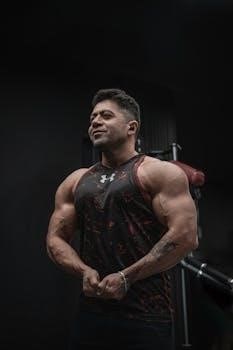
Huberman Workout PDF⁚ A Comprehensive Guide
This guide explores Andrew Huberman’s fitness protocols‚ combining strength‚ endurance‚ and flexibility. It emphasizes a structured approach with 5+ weekly workouts‚ lasting 45-60 minutes. The foundational fitness protocol is available as a PDF‚ detailing specific exercises‚ sets‚ and reps. This comprehensive plan aims to enhance both physical and mental well-being.
Andrew Huberman’s fitness philosophy integrates neuroscience with practical exercise protocols‚ aiming for both physical and mental optimization. He emphasizes a holistic approach‚ incorporating strength‚ endurance‚ and flexibility training into a structured weekly routine. Huberman’s method is not just about aesthetics but also about enhancing overall well-being and cognitive function. He advocates for a balanced approach that considers hormonal balance‚ stress management‚ and recovery. His fitness regimen is designed to be flexible‚ allowing adjustments based on individual needs and goals‚ but with a strong focus on consistency. This involves understanding how different types of exercises impact the body and mind‚ ensuring that workouts are efficient and beneficial. Huberman’s protocols often include specific recommendations for timing workouts‚ incorporating data-driven adjustments‚ and emphasizing the importance of foundational fitness. He promotes the idea that physical fitness is a critical component of overall health‚ impacting not just the body but also cognitive functions‚ mood‚ and overall quality of life. This philosophy encourages a proactive approach to fitness‚ where individuals are empowered to make informed choices about their health.
Huberman’s Weekly Workout Structure
Huberman’s weekly workout structure is designed for optimal physical and mental health‚ incorporating a mix of strength‚ endurance‚ and flexibility training. He recommends exercising at least five days a week‚ with sessions lasting between 45 to 60 minutes to maintain hormonal balance. His routine includes a balance of resistance training‚ cardiovascular work‚ and endurance activities. A typical week might include three days focused on strength and hypertrophy‚ with workouts targeting specific muscle groups. These sessions often involve rep ranges of four to eight‚ with three to four sets per exercise. The schedule also incorporates longer endurance workouts‚ such as 60-75 minute jogs or 2-5 hour hikes‚ primarily on Sundays. Huberman emphasizes the importance of spacing out workouts to allow for adequate recovery‚ suggesting that the specific days are less critical than maintaining consistency. He also allows for flexibility‚ noting that missed days can be made up later in the week. The structure is designed to be adaptable‚ allowing individuals to adjust exercises based on their fitness level‚ preferences‚ and personal goals. The key focus is on maintaining a balanced routine that promotes overall physical and mental well-being.
Strength and Hypertrophy Training Details
Huberman’s approach to strength and hypertrophy training involves a structured methodology‚ typically focusing on three dedicated days each week. These sessions are designed to build muscle and enhance overall strength. He often employs a repetition range of four to eight reps per set‚ with three to four sets for each exercise‚ aiming for muscle fatigue within those ranges. Huberman emphasizes targeting all major muscle groups‚ dividing training into specific muscle group days to ensure comprehensive development. The program includes exercises like squats‚ leg presses‚ leg curls‚ and calf raises for the lower body‚ typically performing 2-3 exercises per muscle group. He also incorporates unique exercises like tibialis raises and neck training‚ which are often overlooked but are crucial for overall fitness. Huberman also highlights the use of tools like weight vests‚ weighted backpacks‚ or carrying children during hikes to enhance workout intensity. He stresses the importance of proper form and controlled movements to maximize effectiveness and minimize injury risk; The specific exercises chosen may vary based on individual preferences‚ but the foundational principle of heavy lifting with low reps for strength and moderate reps for hypertrophy remains consistent. Huberman’s training also advocates for flexibility in exercise choices‚ ensuring all major muscle groups and fitness aspects are covered.
Cardiovascular Training Recommendations
Huberman’s cardiovascular training recommendations emphasize the importance of incorporating regular sessions to enhance heart health and overall endurance. He suggests aiming for at least 35-minute runs at a challenging pace‚ ensuring that multiple fuel systems are engaged for effective muscle activation. This method aims to work both the aerobic and anaerobic systems. The approach focuses on a sustained‚ hard effort‚ but not an all-out sprint‚ to maintain a balance without overstressing the body. He also acknowledges that running isn’t the only option; alternatives like stair climbing‚ burpees‚ or jumping jacks can be used to achieve similar cardiovascular benefits‚ especially if running is not feasible or preferred. It’s important to choose an activity that elevates heart rate and sustains it for the duration of the workout. Huberman’s protocols also stress the importance of consistency‚ suggesting that regular cardiovascular exercise is crucial for both physical and mental well-being. He integrates this with other training elements‚ such as strength and endurance‚ to create a well-rounded fitness program. The specific timing of cardiovascular sessions can be flexible‚ but he often emphasizes the benefits of exercising earlier in the day to align with the body’s natural rhythms. He also stresses the importance of surface flexibility and adjusting workouts to individual fitness levels.

Endurance Training Protocols
Huberman’s endurance training protocols focus on building both aerobic and anaerobic capacity‚ emphasizing long-duration workouts to enhance cardiovascular health and overall stamina. He highlights the importance of engaging in sessions that last 30 minutes or more‚ which are crucial for improving endurance. These workouts should tap into multiple energy systems‚ pushing the body to adapt and become more efficient over time. He recommends integrating activities such as long jogs or hikes‚ ideally lasting 60-75 minutes‚ or even 2-5 hour hikes for more advanced endurance training. These long-duration exercises should be done at a Zone 2 cardio intensity‚ which is a pace that is challenging but sustainable for an extended period. These sessions are not designed to be overly taxing but are meant to build a strong aerobic base. He suggests varying the types of endurance workouts to prevent plateauing and ensure a well-rounded approach to fitness. These can include activities like swimming‚ cycling‚ or other forms of sustained physical activity. He emphasizes that endurance training is not just about physical fitness but also about mental resilience and the ability to push through challenges. Huberman’s protocols aim to maximize physical conditioning and overall health through a comprehensive and balanced approach to endurance exercises.
Integrating Data and Adjusting Workouts
Integrating data is a crucial aspect of Huberman’s fitness approach‚ allowing for personalized adjustments to maximize workout effectiveness. He emphasizes the importance of tracking progress using various tools‚ including fitness apps‚ wearable devices‚ or even simple workout journals. This data-driven approach helps monitor consistency and identify areas that need adjustment. Regular blood analysis‚ using services like InsideTracker‚ is also recommended to personalize nutrition and supplementation plans‚ ensuring that your body receives the necessary support for optimal performance. By analyzing your blood work‚ you can gain actionable dietary guidelines that directly impact your fitness results. Furthermore‚ Huberman highlights the importance of paying attention to your body’s signals and resting pulse rate‚ using these as indicators of recovery and health. Adjustments to workout intensity should be based on how well-rested and healthy you feel‚ avoiding overtraining and minimizing the risk of injuries. He also suggests that flexibility is key‚ allowing for modifications in exercise choices and rep schemes to cater to individual fitness levels and personal goals. The weekly workout structure‚ while providing a solid framework‚ should be adapted to your specific needs and circumstances‚ ensuring that it remains sustainable and effective. By continually monitoring your progress and adjusting your approach based on data‚ you can optimize your fitness journey and achieve better results.
Complementary Resources for Huberman’s Protocol
To complement Andrew Huberman’s foundational fitness protocol‚ several resources can enhance your journey toward optimal physical and mental wellness. Nutrition and supplementation play a vital role‚ with a balanced diet rich in proteins‚ healthy fats‚ and carbohydrates being essential. Huberman often recommends supplements like magnesium‚ omega-3s‚ and other vital vitamins to support recovery and muscle function. Hydration is another critical factor‚ especially during and after workouts‚ with electrolytes being important for maintaining muscle function and overall hydration status. Quality sleep is paramount for muscle repair and recovery‚ and strategies such as maintaining a consistent sleep schedule and creating a cool‚ dark sleep environment are advised. Tools like foam rollers‚ massage guns‚ and stretching routines aid in muscle recovery‚ while cold plunges and sauna use are recommended for stress management. Mental health and focus are also crucial‚ with stress management techniques such as meditation and breathing exercises being beneficial. Furthermore‚ tracking progress using fitness apps‚ wearable devices‚ or journals can ensure consistency in workouts and nutrition. By integrating these complementary resources‚ you can holistically improve your fitness journey‚ addressing both the physical and mental aspects of wellbeing. These elements work together to support the effectiveness of Huberman’s fitness protocol.
Huberman’s Nutrition Tips for Optimal Fitness
Andrew Huberman emphasizes several key nutrition tips to support both physical and mental health‚ which are essential for maximizing the benefits of any fitness protocol. A cornerstone of his approach is the consumption of whole foods‚ focusing on minimally processed or unprocessed options to ensure a high intake of vitamins‚ minerals‚ probiotics‚ and fiber‚ which are vital for cognitive function‚ memory‚ learning‚ and focus. He also stresses the importance of prioritizing dietary protein‚ particularly in the first meal of the day‚ to establish metabolic health and support healthy muscle mass‚ alongside a balanced approach to carbohydrate intake. Huberman often mentions AG1‚ a daily drink that provides foundational nutritional support‚ including vitamins‚ minerals‚ probiotics‚ and fiber‚ as a convenient way to ensure an adequate intake of essential nutrients. Moreover‚ he advocates for regular blood analysis to personalize nutrition and supplementation plans‚ suggesting services like Insidetracker to help interpret blood test results and provide actionable dietary guidelines. These nutritional strategies are designed to optimize both physical and mental performance‚ creating a holistic approach to well-being and enhancing the effectiveness of fitness routines. Adopting these practices can lead to significant improvements in overall health and fitness levels.

Common Fitness Mistakes to Avoid
Andrew Huberman and his guests on the Huberman Lab have highlighted several common fitness mistakes that can hinder progress and potentially lead to injury. One significant error is defaulting to moderate-intensity cardio‚ which many individuals‚ especially women‚ often believe will improve body composition. This type of training can elevate cortisol levels without providing sufficient hormonal benefits‚ thereby impeding overall fitness goals. Instead‚ Huberman emphasizes the importance of incorporating true high-intensity workouts over moderate ones. Another crucial mistake is ignoring proper breathing strategies during and between workouts‚ which can impede recovery and performance. He advocates for focusing on calm‚ intentional breathing to manage adrenaline levels and improve recovery. Additionally‚ deviating from a structured training program too frequently can result in suboptimal outcomes and overtraining. Consistency is key‚ and individuals should stick to their plans unless well-considered adjustments are necessary. Many also make the mistake of lifting light weights with more reps to avoid bulk‚ not realizing it can still lead to hypertrophy. Training heavy with low reps is better for improving strength without significant muscle growth. Finally‚ ignoring sleep and recovery can lead to subpar performance and increased injury risk. Monitoring your resting pulse rate and adjusting workout intensity based on how well-rested you feel are critical for avoiding these mistakes and achieving better results safely.
Beginner-Friendly Workout Advice
For those new to fitness‚ Andrew Huberman’s general principles offer a solid foundation for establishing a sustainable routine. A key piece of advice is to start slowly‚ initiating your fitness journey with manageable routines to avoid injury and ensure consistency. It is crucial to gradually increase both the intensity and duration of workouts over time‚ rather than pushing too hard too early. Huberman emphasizes that building a consistent exercise habit is more important than striving for intense workouts initially. He also stresses the importance of adequate protein consumption‚ particularly in the first meal of the day‚ to support muscle repair and overall metabolic health. Proper hydration before‚ during‚ and after workouts is essential for supporting muscle function and overall performance. Beginners should aim to incorporate a variety of workout types‚ including cardio‚ strength training‚ and flexibility exercises‚ to keep things interesting and well-rounded. Finally‚ sufficient rest and recovery are crucial for muscle repair and growth. Adequate sleep and rest days are necessary components of a well-rounded fitness routine. By following these points‚ beginners can establish a solid and sustainable fitness routine‚ drawn from Dr. Huberman’s general fitness principles.

Beginner Bodyweight Exercises
For beginners‚ bodyweight exercises are excellent for building foundational strength and fitness in a safe and structured manner. These exercises require no equipment and can be performed anywhere‚ making them highly accessible. Andrew Huberman and Andy Galpin have discussed a squat progression‚ which is a fundamental movement for beginners. This progression can be tailored to individual fitness levels‚ ranging from completing it in one session to taking up to two years‚ depending on comfort and prior injury history. This personalized approach allows beginners to gradually increase their strength and improve their form without overexertion. In addition to the squat progression‚ other beginner bodyweight exercises include push-ups‚ which target the chest‚ shoulders‚ and triceps; planks‚ which strengthen the core; lunges‚ which work the legs and glutes; and rows using a sturdy table or chair to work the back and biceps. These exercises‚ alongside the squat progression‚ provide a well-rounded foundation for beginners focusing on bodyweight training. It is essential to ensure proper form and controlled movements to minimize the risk of injury. Always adjust the intensity and repetitions based on your fitness level and personal goals.
